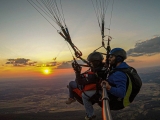The Spanish ISF oversees the organisation of snowboard competitions and regulates the scoring system, which aligns with international standards. However, Spain goes a step further by including two additional disciplines with their own national rankings: Big Jump and Freeride.

The competitions with global rankings are:
- Duel
The slope for this event has an elevation drop of 80 to 150 metres and is as uniform as possible to allow two identical tracks. Gates are marked by poles with swivel bases and triangular flags, spaced 7 to 12 metres apart.
The competition consists of 2 qualifying rounds and a final heat under a knockout system. Women compete before men, and as per international rules, the top-ranked riders from the World Ranking lead the event. In the first qualifying round, even-numbered riders start on the right side of the course (viewed from start to finish), while odd-numbered riders start on the left.
- Carving
The competition format includes 2 runs: 1 qualifying run and 1 final run. The top 12 women and top 24 men advance to the final. The total score is the sum of both run times.
Originally called "giant slalom," carving was renamed to distinguish it from skiing and other winter sports.
- Halfpipe
Derived from skateboarding, this discipline takes place on a flat track 50 to 110 metres long and 12 to 18 metres wide, with vertical walls (2 to 3.5 metres high) on either side. Riders traverse from wall to wall, executing manoeuvres to demonstrate their skill.
Per ISF rules, there are 2 rounds for women and 2 for men, with the top 8 women and top 16 men advancing to the final. Judges determine the winner based on speed, amplitude, balance, and landing precision.
- Snowboard Cross
The event starts with a timed qualifying round where riders descend individually. The fastest then compete in groups of 4 in a knockout-style final.

In Spain, alongside the above snowboarding disciplines, two additional categories have their own rankings:
- Big Jump: A crowd favourite, this discipline involves jumps from a ramp 2.5 to 4 metres high. Distances can exceed 20 metres in length and 4 metres in height, creating a spectacular show—especially at night events.
- Freeride Events: Participation in these races through the National Federation automatically registers riders with the ISF. Maximum entries are capped at 40. Held off-piste (outside ski slopes), they use natural terrain as obstacles, with strict safety measures. Judges assign scores.

Now that you know the ins and outs of these competitions, experience the thrill of snowboarding—watch live, on TV, or even take part. If you choose the latter, remember to train properly to avoid injuries. Discover a new passion with snow competitions.











